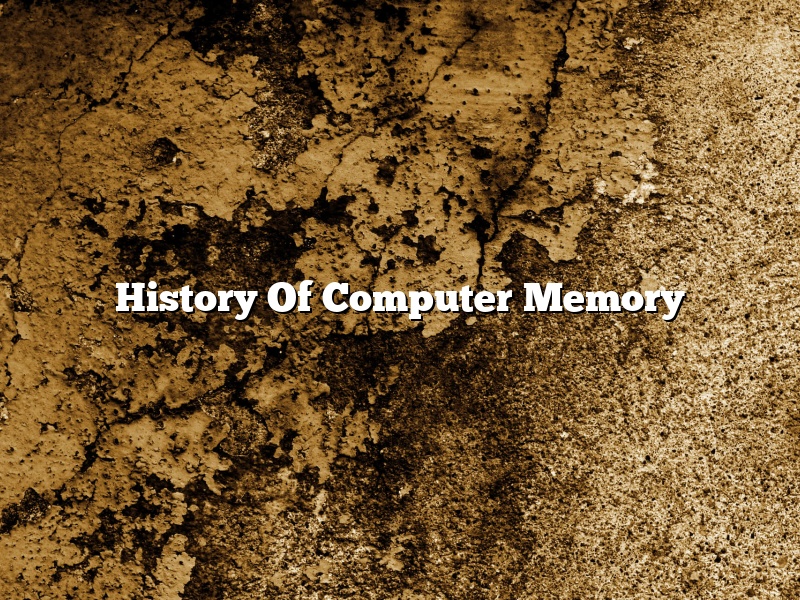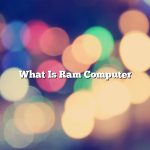The history of computer memory can be traced back to the 1940s when the first computers were created. These computers were extremely large and required a lot of space, so the early computer developers had to come up with a way to store data and programs on the computer.
One of the first methods of computer memory was the use of magnetic drums. Magnetic drums were large metal cylinders that could store data and programs on a spinning disk. The data and programs were written on the drum using a magnetic head, and the drum could then be read by the computer.
Another early form of computer memory was the use of punched cards. Punched cards were thin pieces of paper that had small holes punched in them. The holes represented the data or program that was stored on the card. The cards could be read by the computer by using a special reader that would scan the holes and convert them into electrical signals.
In the 1950s, the first magnetic storage devices were created. These devices were called magnetic tapes, and they worked similarly to magnetic drums. However, instead of using a spinning disk, the data was stored on a long strip of magnetic tape. Magnetic tapes were used extensively in early computers, and they were eventually replaced by magnetic hard drives.
In the early 1960s, magnetic hard drives were developed and began to be used in computers. Magnetic hard drives are similar to magnetic tapes, but they use a spinning disk to store the data. Magnetic hard drives are still used in most computers today, and they are the main storage device for data and programs.
Over the years, a number of different computer memory technologies have been developed. However, the three main types of computer memory are magnetic storage, random access memory (RAM), and flash storage.
Magnetic storage is the oldest type of computer memory, and it is still used in most computers today. Magnetic storage uses a spinning disk to store data, and it is the main storage device for data and programs.
Random access memory (RAM) is a type of computer memory that can be accessed randomly. This means that any byte of data can be accessed without having to read through the entire memory. RAM is used to store data that is currently being used by the computer, and it is volatile, which means that it is lost when the computer is turned off.
Flash storage is a type of non-volatile computer memory that can be accessed randomly. Flash storage is used to store data that is not currently being used by the computer, and it is used extensively in portable devices, such as smartphones and tablets.
The history of computer memory is a fascinating topic, and it is interesting to see the different technologies that have been developed over the years. Computer memory is an essential part of every computer, and it plays a vital role in the operation of the system.
Contents
What is the history of computer memory?
The history of computer memory traces back to the early days of computing, when memory was an extremely scarce resource. The first computers were limited to a few kilobytes of memory, which was barely enough to store a handful of instructions.
As computer technology advanced, memory became increasingly cheaper and more plentiful. By the late 1990s, personal computers were commonly equipped with several gigabytes of memory, which was more than enough to store an entire operating system and thousands of applications.
Today, computer memory is even more plentiful and cheaper than ever before. Modern laptops typically come with at least 8GB of memory, and high-end gaming PCs can have up to 64GB.
Who invented computer memory?
In the early days of computing, memory was a precious resource. Every byte had to be carefully allocated, and every program had to be written to make the most efficient use of memory.
This all changed in the early 1950s, when computer scientists began to develop ways to store data outside of the computer’s main memory. This external storage was known as secondary storage, and it allowed computers to store far more data than was possible with main memory alone.
The first type of secondary storage was magnetic tape. Magnetic tape was expensive and slow, but it could store a lot of data. In the 1970s, magnetic disk drives became popular, and they soon replaced tape as the primary means of storing data outside of the computer’s main memory.
In the 1980s, the personal computer revolutionized computing, and with it came the advent of the hard drive. The hard drive is a magnetic disk drive that is installed inside the computer. It is much faster than a magnetic tape drive or a magnetic disk drive, and it can store a lot more data than either of those devices.
Today, the hard drive is the primary means of storing data outside of the computer’s main memory. It is used in both personal computers and enterprise-level servers, and it is responsible for the vast amounts of data that are stored in the world today.
When was the first memory of a computer?
The first memory of a computer is a difficult question to answer, as it depends on what you consider to be a computer. The first electronic computer, ENIAC, was created in 1946, but it relied on vacuum tubes and other electro-mechanical components, so it’s not clear if the first memory of that computer would be considered the first memory of a computer in general.
Some people might argue that the first memory of a computer was actually created in 1801, when Joseph-Marie Jacquard developed a loom that could be controlled by a series of punched cards. This allowed for the creation of detailed patterns that could be reproduced over and over again, effectively creating the first computer program.
However you choose to define it, the first memory of a computer was an important development in human history, and it has continued to evolve and improve over the years.
What are the 3 types of computer memory?
There are three types of computer memory: primary, secondary, and tertiary.
Primary memory, also known as internal memory, is the memory that is physically installed on the computer. This type of memory is volatile, meaning that it loses its contents when the power is turned off.
Secondary memory, also known as external memory, is a type of memory that is not installed on the computer. This type of memory is non-volatile, meaning that it retains its contents even when the power is turned off.
Tertiary memory, also known as long-term memory, is a type of memory that is not installed on the computer and is not volatile. This type of memory is used to store information that is not regularly accessed.
What is computer memory?
Computer memory is a collection of electronic circuits that temporarily store data and programs while the computer is running. There are many different types of computer memory, but the most common are random access memory (RAM) and read only memory (ROM).
RAM is a type of computer memory that can be accessed randomly. That means you can access any memory location without having to go through all the other locations first. This makes RAM ideal for storing data and programs that are currently being used by the computer.
ROM is a type of computer memory that can only be accessed sequentially. That means you can only access memory locations one at a time. This makes ROM ideal for storing data and programs that are not currently being used by the computer.
Both RAM and ROM are important for the overall performance of the computer. RAM is necessary for the computer to store data and programs that are currently being used, while ROM is necessary for the computer to store data and programs that are not currently being used.
What is computer memory explain?
Computer memory is a key component of all computer systems. It is used to store data and programs while the computer is turned off, and also to provide fast access to these items while the computer is running.
There are many different types of computer memory, but the most common are random access memory (RAM) and read-only memory (ROM). RAM is used to store data and programs that are currently being used by the computer, while ROM is used to store data and programs that are not currently being used but that the computer needs to access quickly.
The amount of memory a computer has determines how much data it can store and how quickly it can access that data. When choosing a computer, it is important to consider how much memory it has and what type of memory it uses.
What is computer memory and types?
Computer memory is a component of a computer system that stores data and instructions. The three most common forms of computer memory are random access memory (RAM), read-only memory (ROM), and hard disk storage.
RAM is the most common type of computer memory. It is a type of volatile memory, which means that it loses its data when the computer is turned off. RAM is used to store the operating system, applications, and data that are being used by the computer.
ROM is a type of non-volatile memory. It is used to store the firmware and basic operating system instructions for a computer.
Hard disk storage is a type of non-volatile memory that is used to store data and applications.




